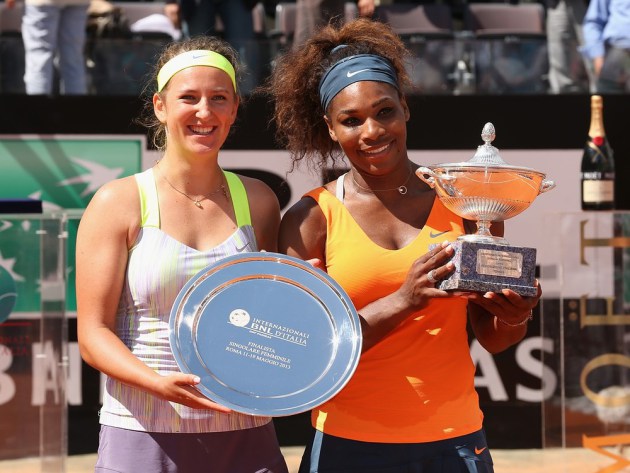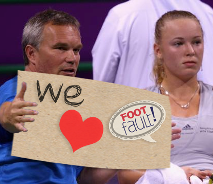
There she stands again; trophy in hand, smile on face and right leg bent just that tiny bit at the knee as she assumes the pose. As always, Serena Williams is accompanied by a taller but less enamored blonde who carries the consolation plate for walking helplessly into yet another defeat by the American. On days she is dispatched with ease, there is usually a smile too. As the loser takes her final bow, Williams invariably busts into a variety of gleeful poses, hamming it up to the delight of the flashing cameras.
The scene has become all too familiar.
The reactions are familiar too. If Spain, the site of Williams’ title-before-last, stood to gain a Euro every time it was suggested that Williams is currently “better/fitter/faster/stronger than ever”, their insolvency woes would have long since become a figment of a past long ago, making way for gleeful affluence.
As it stands, they don’t. Nor does this statement - irrespective however many times blindly repeated - carry any truth whatsoever. Of course it’s not true. Is she great, brilliant, spectacular, and majestic? Oh yes. But the idea that this 31 year-old is somehow greater than a decade younger version who shrugged at one of deepest elite fields in WTA history, tearing it apart as she waltzed to four straight grand slams? Such absurdity is enough make even Yanina Wickmayer chuckle.
The greatest compliment that can be paid to Serena after a renaissance that has seen her at least attempt to fit 12 singles trophies in 13 months into the surely already overstuffed Williams trophy room, is that she has adapted like no other player in the history of tennis. So often it is her power that captures all the attention, but what catapulted her to such unrivaled dominance during her peak and formed the centerpiece of her game was her athleticism. In addition to her technical and mental gifts, Williams brought to tennis such an unheard of physicality to her tennis. On the ball she was impressive enough, but between strokes she demonstrated such a breathtaking level of intensity, speed and intricate footwork.
As the unavoidable nemesis of age grows stronger, it’s only natural that these physical gifts begin to wane. Age has, of course, proved the ultimate rival of many greats before her. But unlike most, Williams’ talent is so great that age has simply forced her to remortgage her game to rely more heavily on different strengths - to change her spots. As she began to navigate her late twenties, a deadly concoction rapidly bubbled under the surface. Though always a great and iconic weapon, slowly but surely Williams’ serve has transformed and improved beyond the realms of human imagination. With her smooth and effortless motion, she has achieved technical perfection, which allows her to create maximum power, deadly placement and unreadable variety with seemingly minimal effort.
The security Williams’ serve offers her cannot be understated. It has opened up a whole realm of new possibilities, allowing her to be more consistently aggressive than ever, ensuring that points are even shorter and offering her the opportunity to consistently take great swipes at both first and second serve returns. Though she remains one of the quickest players on the tour, the result is that this reliance on her athleticism, movement, footwork and intensity has shrunk considerably. It’s a maddening sight for her fans, as she has abjured almost the entire concept of footwork, but the result is that her game less intense, less physical and, therefore, less taxing to her body. In short, over the latter part of her career Williams has completely changed the nucleus of her game yet, despite that, still stands as the undisputed number one.
It was curious then that one set into this tussle with Victoria Azarenka, the world number one had landed a pathetic 45% of her first serves against the best returner in the world and the woman who had defeated her in their previous meeting. Despite that, as she strutted to her chair, only one single game had been offered to the Australian Open champion. For a player so reliant on her serve on the surface that, in theory, requires her to be at her sharpest and most efficient on serve simply to have a chance, how could this be possible?
Judging by Williams’ play throughout the final, the answer is quite simple. She simply tossed aside every pre-conceived notion of her game. In stark contrast to the risk-taking aggressive mentality that she has become so renown for, she appeared transfixed on making as few errors as possible and adhering to the surface’s core rules. She continued to play aggressive tennis, of course, but her aggression was tempered and cushioned with margin and care. Rather than any blistering forehand or nuclear backhand, her biggest asset throughout the match was the manner in which she manipulated the ball into every single angle of the court and picked apart her opponent rather than blasting through her.
The flat-footedness onlookers have become accustomed to was offered a temporary on holiday as Williams focused so diligently on her movement. At times she even happily offered Azarenka the initiative in points because she was so comfortable on the run. Not only did she navigate the court magnificently, the movement that was so uncomfortable on the surface a weak earlier had seen such a dramatic improvement - both from the small balance-ensuring slides when the ball was close by, to the long and effortless sliding at full stretch. So often the Belarusian would attempt to either pin Williams into a corner or force her on the run, but Serena would simply wait patiently until a gap appeared, before ruthlessly uncorking an angle to send her opponent scuttling after it. The match proved a perfect demonstration of just how sizable the distance between good and great is, with Azarenka unable to attempt anything other than her standard, regular brand of tennis against Williams, while Williams chopped and changed certain aspects of her game yet the outcome remained the same.
And so they stood there once again. Of Serena’s eight Tier I, Olympic and Slam titles over the past 13 months, seven times (Azarenka 3, Sharapova 4) this scene has repeated itself. The world number one has now won 82 of her last 86 matches. If this dominance isn’t reason enough for her to pose and milk the cameras for all she’s worth, then not much is.
Like this:
Like Loading...


